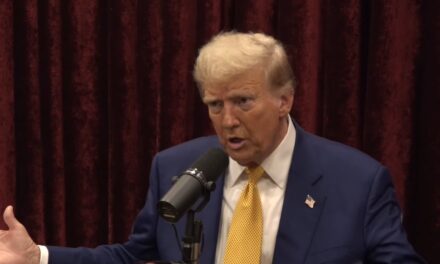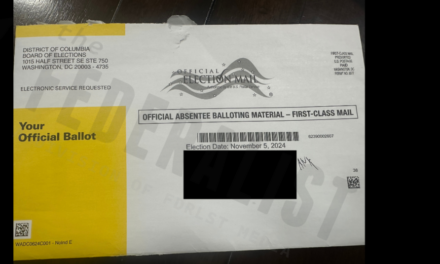We support our Publishers and Content Creators. You can view this story on their website by CLICKING HERE.
Donald Trump’s rally in New York City’s iconic Madison Square Garden was much more than a campaign event in symbolically hostile territory; it was part of a broader strategy aimed at achieving not only victory but also a resounding national mandate.
At first glance, the decision to hold a high-profile rally in New York — a state Trump has little chance of winning — might seem curious to observers, but it signals the campaign’s confidence.
Tactically, the event in New York City does two things. First, it bolsters Republican House seats in New York won in 2022 due to former Rep. Lee Zeldin’s strong run for governor. Second, because the New York media market extends to Pennsylvania, it nudges the Keystone State further into Trump’s camp.
But Trump is playing a bigger game, seeking to secure both the Electoral College and, for the first time since 2004, a Republican victory in the national popular vote. This dual victory would provide Trump with a mandate strong enough to propel an ambitious second-term agenda and reinforce the Republican position in both the House and Senate.
In today’s turbulent political climate, winning the popular vote has a critical symbolic and practical importance — potentially muting post-election violence from the radical left that some fear.
If Trump not only secures the presidency but also wins over a majority of Americans nationally, he will be uniquely positioned to dispel the manufactured legitimacy concerns designed to drive him from office or, at the very least, hinder his term. The mandate would not only provide Trump with the backing needed to implement his agenda but would also help foster a sense of unity and legitimacy for his administration, which is crucial for national healing in a deeply divided country.
Strategic Importance of the Popular Vote and Senate Majority
In the immediate term, a Trump popular vote win would greatly benefit the GOP by enhancing down-ballot support for Republican candidates. RealClearPolitics’ polling suggests that many key races for the House and Senate are close. With a Trump-led wave, Republicans are positioned not just to hold their majority in the House but also to potentially expand their influence in the Senate.
Such gains would be pivotal: Republicans have a tough Senate map to navigate in 2026, in which they will need to defend more seats than the Democrats. An increase in Senate seats now, perhaps to 54 or even 56, would help safeguard their legislative priorities well beyond 2024, mitigating the typical midterm losses and giving Republicans more time to enact critically needed structural changes.
With a substantial majority in the Senate, Trump would have a far greater capacity to push through high-level appointees and judges. During his first term, Trump found his conservative appointments to the federal judiciary among his most enduring accomplishments, reshaping the courts in a way that will benefit American jurisprudence for decades. A Republican-controlled Senate would allow Trump to continue this transformation, securing appointments to the Supreme Court and federal benches that align with his administration’s originalist philosophy. Additionally, this would make it significantly easier to confirm key administration figures, helping to avoid the roadblocks that slowed his first term.
For Trump, a clear Senate majority represents more than just filling judicial seats. It’s about having the ability to move forward on an ambitious, transformational agenda. Unlike in his previous term, where legislative initiatives often stalled due to opposition or lukewarm support from Congress, a Senate majority offers Trump the potential to address America’s mounting challenges, including the burgeoning federal debt, a rekindled industrial policy, and an intensifying threat from the People’s Republic of China. These issues demand focused and sustained effort, which a Republican-controlled Senate could facilitate across a full four-year term, rather than a truncated two-year window.
Discrediting Corporate Media and the Censorship-Industrial Complex
Alongside a push for both the Electoral College and popular vote wins, Trump is challenging the corporate media and the incestuous partnership it has developed with both the U.S. and foreign governments to censor citizens, shackling the free press. This censorship-industrial complex fuses major media, tech giants, and federal influence to shape public discourse and narratives. For Trump and his supporters, these institutions are seen as obstacles not only to his campaign but also to transparency and trust in American media.
By staging high-profile events outside the conventional media channels, such as his recent marathon three-hour interview with Joe Rogan, Trump is reaching millions of Americans directly. Creeping up on 40 million views in just a few days, the Rogan interview dwarfed Kamala Harris’ recent scripted town hall on CNN, which garnered only 3 million views, and her appearance on the “Call Her Daddy” podcast, which reportedly averages about 10 million listeners each episode.
Trump’s ability to bypass traditional media channels and appeal directly to a massive audience is not just about attracting votes; it’s about shifting the public’s understanding of news and information. A second Trump administration, bolstered by a clear mandate from the popular vote, would be in a stronger position to challenge media narratives and push back against media-driven misinformation.
Healing a Divided Nation Through a Strong Mandate
One of the most pressing needs for a second Trump administration is to heal a divided nation. Trump’s critics often point to his brash style as a source of division, yet Trump’s strategy suggests he understands that a strong mandate would give him a better chance at bridging divides. Winning the national popular vote, with significantly increased support from both black and Hispanic Americans, would not only reinforce his legitimacy but could serve as a unifying force. This mandate could give him the political capital to engage in difficult policy efforts.
In this light, Trump’s Madison Square Garden rally takes on added significance. It’s not simply a campaign stop in an unwinnable state; it’s a bid to unify and rally a national coalition.

 Conservative
Conservative  Search
Search Trending
Trending Current News
Current News 





